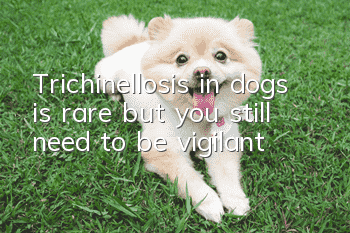Trichinellosis in dogs is rare, but you still need to be vigilant!

Canine trichinellosis
This disease is an important zoonotic parasitic disease. It is known that more than 100 species of animals can be infected with trichinellosis under natural conditions, including carnivores, omnivores, rodents and humans. Among them, there are at least 65 species of mammals, and among domestic animals, pigs and humans are the main ones. The infection rate of Trichinella spiralis in dogs in the three northeastern provinces of my country is very high.
The pathogen of canine trichinellosis and its life history
Trichinella spiralis is a very small white nematode that is thin at the front and thick at the back. The male worm is 1.4~1.6 mm long, and the female worm is 3~ long. 4 mm, barely visible to the naked eye. Lives on the intestinal wall of the small intestine.
The characteristic of its life history is that the same animal is both a definitive host and an intermediate host. When humans or animals eat meat containing cysts of Trichinella spiralis larvae, the cysts are digested and the larvae escape and burrow into the mucosa of the duodenum and jejunum. They develop into adults in about 1.5 to 3 days. After mating, The male worms die, and the female worms burrow into the dog's intestinal glands or submucosal lymphatic spaces to give birth to larvae. Some of the larvae in dogs are spread throughout the body with the bloodstream. Striated muscle is the most suitable parasitic site for Trichinella spiralis larvae. The larvae that first enter the muscle fibers are straight, then develop rapidly, gradually curl up and form cysts. The cysts in dogs are round in shape, measuring 0.25 to 0.3 mm x 0.4 mm in size, and appear white and needle-shaped when viewed to the eye. The cyst contains cyst fluid and 1 to 2 curled larvae, and some individuals can reach 6 to 7 larvae. The cysts begin to calcify within a few months or 1 to 2 years, and larvae with calcified cysts can still survive for several years.
Key points for diagnosis of canine trichinellosis
The main clinical manifestations of this disease are fever, muscle pain, and edema. However, the symptoms of naturally infected dogs are difficult to detect, and antemortem diagnosis is difficult. If necessary, muscle biopsy can be taken, and enzyme-linked immunosorbent test or indirect hemagglutination test can also be used. Diagnosis can be made after death by the presence of larvae in the muscles. You can take a small piece of each of the left and right corners of the breast muscle (or psoas muscle, or abdominal muscle), then cut it into 24 small pieces of a wheat dog, and use a thick glass slide for microscopic examination (20~50X).
Measures for the prevention and control of canine trichinellosis
Promote good hygiene, eliminate rodents, and burn or bury the corpses deeply. It is prohibited to discard animal carcasses and offal at random. Carcasses with Trichinella spiralis detected should be dealt with in accordance with regulations. Raw meat fed to dogs must undergo a sanitary inspection to prove that it is free of Trichinella spiralis before it can be fed. Trichinellosis can be treated with propylthioacil at a dosage of 25 to 40 mg/kg body weight per day, taken orally in 2 to 3 times, and a course of treatment lasts for 5 to 7 days.
- What do dogs eat to protect their stomach? It is important to protect their stomach and treat gastrointestinal diseases in dogs.
- How to tell if your dog is fat? Is your dog overweight?
- Will your dog catch a cold if you blow the air conditioner? What should you do if your dog catches a cold if you blow the air conditioner?
- What should you pay attention to when your dog drinks water? Don’t be careless when it comes to your dog’s drinking water.
- The dog's mouth bites and shakes. Why does the dog's mouth occasionally shake and bite?
- How to cut a dog's hair? Do you know how to cut a dog's hair correctly?
- Can dogs eat raw eggs? Why can’t dogs eat egg whites?
- Common Dog Problems in Summer How to Deal with Different Dog Problems
- How to keep dogs away from skin diseases. If you do this, will you see if your dog will still be infected with skin diseases?
- What causes anorexia in dogs? Dogs will become anorexic due to lack of exercise. Hounds run at least 5KM every day.



